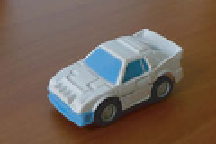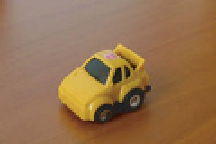Graphics Reference
In-Depth Information
(a)
(b)
(c)
Figure 5.25.
(a) User-defined line segment correspondences for the field morphing algorithm.
(b) Line segment positions and image warps corresponding to
t
=
0.5. (c) The final morphed
image is the average of the images in (b).
To apply fieldmorphing, we first define corresponding line segments for an image
pair, and then interpolate corresponding line segment endpoints to determine the
intermediate line segment positions in the warped image for each
t
. We then warp
each source image from the original line segments to the intermediate line segments,
and cross-dissolve between every pair of warped images. Figure
5.25
illustrates an
example of user-defined line segment matches between an image pair and a halfway
image created with the induced dense correspondence.
This algorithm is somewhat heuristic, so caremust be taken to define “good” pairs
of line segments to make a compelling transformation. For example, line segments
shouldnot cross, anda segment should span the same apparent region inboth images
to prevent artifacts that arise from the underlying correspondence field folding back
on itself (i.e., being non-diffeomorphic). Typically line segments are added andmod-
ified in an iterative process until an acceptable morph is created. Schaefer et al. [
422
]
showed how the as-rigid-as-possible deformation algorithm for interpolating scat-
tered data discussed in Section
5.2.4
can be modified to operate on correspondences
between line segments, resulting in more natural deformation fields than Beier and
Neely's original algorithm.
Lee et al. [
269
] noted that the cross-dissolve step in Equation (
5.62
) can be gen-
eralized to allow the two images to warp toward each other at different rates; for
example, we could replace
t
in Equation (
5.62
) with any function
f
that monoton-
ically increases from 0 to 1. Even further, we can allow this function to vary spatially,
so that different regions of the image move and dissolve at different rates. Wolberg
[
551
] gave a good overview of morphing algorithms and further extensions.
(
t
)
VIEW SYNTHESIS
5.8
Once we have dense correspondence between a pair of images, in certain circum-
stances we can create new images of the same scene as it would have appeared from
different perspectives. This problem is called
view synthesis
, or sometimes
virtual
viewsynthesis
to emphasize that the constructed viewwas not acquiredby any actual









